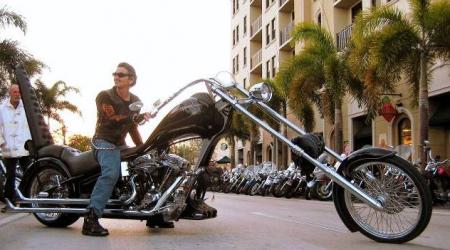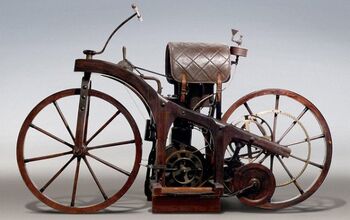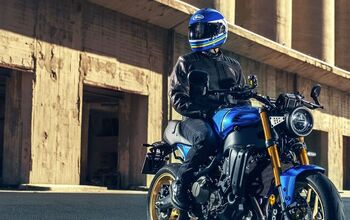Top 10 Weirdest Custom Motorcycles
Motorcyclists by their very “outlaw” perspective on transportation tend to dance to a different drummer. Whether you’ve strapped a Briggs & Stratton lawnmower engine to your Schwinn Stinger bicycle or carved a custom chopper from a solid block of billet aluminum, the impetus for creating two-wheeled “kinetic art” is the common denominator where the uncommon is common. Case in point, the smorgasbord of “custom bikes” seen here. Ours is not to judge, only to give the thumbs up to the road less taken.
The Biggest: GUNBUS 410 – World’s Largest Ridden Motorcycle
You’re not hallucinating… the people seen with this bike are not elves. It’s the bike that’s gone hormonal. As they say in its place of manufacture, German… it’s Ungeheur! A Monster! But as far as we can tell it’s not packing any armament, guns or otherwise, however the name GUNBUS 410 does somewhat qualify. It’s almost as a big as a “bus” thanks to its Paul Bunyanesque size.
Built by a company called Leonhardt Manufacturing, named for its founder Clemens Leonhardt, the GUNBUS 410 is massive in all proportions including the design theory and fabrication process that went into its creation. And it’s not merely a concept bike just for show. It’s passed all the strict German testing procedures and is street legal and stands tall as the world’s largest ridden motorcycle. While measuring 11.3 feet in length, you climb into a saddle with a reasonable seat height of 31.5 inches (same as a Buell). A triple set of 310 mm disc brakes bring the 1433 lb. monster to a halt.
As its name implies the powerplant, a V-Twin, is of 410 cubic inches. True, the Boss Hoss is available on 502 cubic inches but that’s in an 8-cylinder, not two as in the GUNBUS. It puts out a purported 350 HP and 523 foot pounds of torque. Electronic speed controls “limit” the machines top speed to 150 mph. Enough to get around on the Autobahn. And check out the tires. While originally to be sourced from a Boeing 746 jetliner, they were custom made in Germany by a company called Rigdon. The front measures 38 in. x 11 in wide, the rear 42 in. x 15 in.
Doing the math, it figures out that the GUNBUS 410 weighs twice as much as the average full-size V-twin cruiser, but also has four times the displacement and almost six times the torque of a Harley Twin Cam 96 (92 ft/lb). As one observer noted, by that measure the GUNBUS is a relative featherweight.
Leonhardt has been creating “specialty vehicles” since the 1970’s. Speaking from his NASA-style facility located near Heidelberg, Clemens Leonhardt says “It all started with a massive wheel from a WWII vintage Heinkel bomber and grew from there over a period of three years. As far as the name GUNBUS it’s taken from a WWI blimp that had the shape of a gun and was as big as bus.
After developing the prototype high piston capacity V-Twin engine, they began work on the Gunbus 410, the prototype debuted to the public at the beginning of 2008 and then appearing at many major events in Germany. Yes, you can have one in your garage if it and your wallet are big enough. This is literally a bike that eclipses all others and the price tag reflects, that. Base price is 190,000
Euros.
The Longest: Seating for Three
This bike stopped traffic when it pulled in recently for the weekly bikefest held in Lake Worth, Fla. a couple minutes from posh Palm Beach. Measuring 13 ft. 5 inches, it was piloted by its builder/owner Steve Martino, originally from New York and now acclimated to the balmy life in the Sunshine State.
Says Steve, “It started out as dream. I guess I was really thinking big. I hand-fabricated it at home in 2004, starting with a custom frame from Killer Choppers in New Hampshire.” Steve stuffed a100 inch RevTech in the frame, stretched the Fatbob tanks to seven gallons and added two shifters and two clutch controls, one up on the custom made bars, the other attached to a suicide shifter on the left side. And yes, the seat and mile high sissy bar can accommodate three people although the police tend to frown on it but can’t seem to find a law against it.
The Fastest Chair: Getting to Work is a Blast
Feel like doing 130mph sitting in a chair? Well buckle-up in aircraft inspector Tom Ridyard’s homebrewed commuter built some years ago. Tom first got the sidehack bug 40 years ago, in fact employing a sidecar on his very first date, a box with a 180cc Yamaha motor, his own creation. Later he would conjure up a variety of street and racing sidecars and began competing in both dirt track and roadracing sidecar events, even winning at the Ascot and competed in Sweden, Denmark, Germany, France, Belgium and Holland.
His Flying Red Chair features a special chrome moly frame hand built by another leading sidecar enthusiast and Jet Propulsion Laboratory engineer, Jerry Pearson, of Pasadena, Calif. The design features a mono-shock rear suspension (the shock absorber “borrowed” from a Corvette) and leading link front suspension. After acquiring the frame, Tom shopped around for an inexpensive engine, eventually transplanting the 1000cc Kawasaki “police bike” powertrain from a parts bike that originally served about 60,000 miles with the Arizona Highway Patrol. Ever budget conscious, Tom also made the sidecar’s fiberglass body parts from molds originally created by Jerry. A pair of 650 Yamaha mufflers quiet the Kawi’s exhaust note since Tom figures the mere sight of the hack terrifies most motorists.
“It feels much like steering a bicycle,” says Tom. “Just sneeze and you change lanes. Riding side by side with an 18-wheeler is a better morning wake-up than a cup of coffee.”
The Smallest: Plumbing an 80mph Puttster
“I had worked on some ‘60s Honda Cubs in the past, and when I saw this bike on Craigslist, black and rusty, my heart fell for it. I took it completely apart and cleaned it up and started riding. But when the rear swingarm grenaded at 80mph down the Pacific Coast Highway, I decided to try some “modifications” like stretching the swingarm. I bought the pieces from Home Depot and started welding and added 8.5 inches to the wheelbase. This bike came with a 90cc engine but I replaced it with a 140cc, a 10:1 compression engine from a Chinese dirt bike and with a 30mm Mikuni.”
Patrick also did some cutting and trimming here and there, like the rear fender and the “Swiss cheese” hole through the center of the frame. Brakes on the 17-inch wheels are still stock original as are the leading link front end and shocks.
"Donning a welder’s mask, he made the sutures and was up and running again – at 80 mph on the L.A. freeways. We do not exaggerate."
A residential and commercial plumber by trade, Patrick had just ridden his “stretched” 1964 Honda C200 the 75 miles to Venice, Calif. and a shop called SS Classic Cycles to do some repairs on his bike, the exhaust pipe having cracked. Donning a welder’s mask, he made the sutures and was up and running again – at 80 mph on the L.A. freeways. We do not exaggerate. As seen in these photos, both Patrick and his bike, were about to do the return 75 miles.
“It’s a work in progress. I’ll come up with a seat and taillight later,” says Patrick who carries the bike’s license plate stuffed in the back of his backpack. So far, no police intervention.
Stepping into the Purple Haze: A Merging of Modes of Transport
The Deco Liner 1939 Lincoln Sedan Delivery known as “Scrape” took ten years of dreaming and three years of construction to create by its U.S. owner Terry Cook of Long Valley, NJ. The one-of-a-kind hybrid vehicle features a unique front wheel drive chassis fitted to a custom built “Sedan Delivery” body. Both the car and bike it transports were completed after a six month workathon orchestrated by Cook during and constructed by Brown’s Metal Rods located in Indianapolis, Ind.
Cook conceived the concept of tucking a custom built '92 Harley Sportster inside the delivery after designing the car's body shape with Illinois artist Frank Nicholas. An aluminum U-channel ramp moves in and out of the back of the car at the touch of a switch. The bike is rolled onto the ramp, strapped in position, and the ramp is electrically moved into the car.
Cook feels the concept blends car and motorcycle. As for the “art deco” treatment seen in the paint and chrome trim, he says it’s based on the mid-1930's Paris coach-built cars which often used ornate metal trim.
As for the custom ’92 Harley Sportster, the construction was begun by Juan "Motyme" Rice of Chicago, then Denny Jamison of Automotive Hammer Art of Gasoline Alley located in Indianapolis hand-shaped both the streamlined aluminum body and metal trim for the “Deco Scoot.” Chrome plating for the trim was done by The Finishing Touch of Chicago. (In the photos, because of the lighting, the chrome trim looks like its paint but in reality it is all hand-fabricated and polished chrome.) The extreme paintwork is RM “Carizzma” True Violet pearl pearlescent purple. For more information contact http://www.decorides.com/ or call his U.S. offices at 908-876-9100.
The Badassest: Transformer Boss Hosses
When Hollywood producers making George Clooney’s recent movie “Leathernecks,” a story about early 1900’s football, they wanted the hero to putt around on a correct piece of machinery – they came up with a 1918 Indian V-Twin with a sidecar. Only problem was when they actually went to buy the real McCoy, it was way expensive and they couldn’t even get it started, much less ride smoothly and quietly around the movie set cameras. Then someone came up with the solution: call Eddie Paul at his El Segundo, Calif. “skunkworks.” Eddie, a legendary stuntman/inventor, saved the day by creating exact Indian clone bikes on the spot. These bikes were operated by silent running and trouble free electric motors at a fraction of the cost of originals.
For his personal transportation Eddie prefers something with a bit more performance. Of his three Boss Hosses one is called “Chopper One” a red, white blue in homage to the President’s Air Force One, minus the wings but not the horsepower. The bike comes stock with a 350 cubic inch Chevy V-8 to which Eddie added supercharging and nitrous oxide, good for about 1700 HP. “I figure it’s good for about 300 mph, but I find it gets me to the grocery store just fine,” says Eddie, who once rode a bike 268 miles with his hands behind his back for the Guinness Book of Records.
Talk about a Streetfighter, when traffic gets tough, Eddie gets tougher and rolls out his rotary machinegun/rocket launcher equipped Camo Bike built for the Air Force to attract new recruits. They liked it so well they contemplated making the real thing for use in Iraq.
Best Dressed: Yes, You Can Take It With You…
Getting Hacked takes on a whole new meaning when you climb into this beautiful “woody” Honda Goldwing combo – owned and ridden extensively by Mike Smith of Lancaster, Calif. Mike has been three-wheeling for more than 35 years. The handsome “mobile home” was hand built by sidecar guru Doug “Mr. Sidecar” Bingham, the nation’s leading force behind the promotion of the joys of sidecar riding. Back in 1969 Doug founded a company called Side Strider and puts on the annual Griffith Park Sidecar Rally, coming up Nov. 7.
Most Electrifying: Carl’s Science Project
Several years ago Carl Vogel, of Vogelbilt Corporation in Oak Beach, NY, built the prototype for his electric-powered motorcycle as an engineering school project.
The Electra Cruiser took part in a TV series called “Eco-Trekker,” created by Australian Shaun Murphy who rode it and other alternate fueled vehicles 16,000 miles across the U.S. His buddy “Sparky” went along for the ride.
Said Carl, “It was my belief that a one of a kind vehicle could be built using simple and innovative designs. The result is a unique, rugged, retro looking design that is well balanced, comfortable, and fun to ride. And most of all it is a ZEV (Zero Emissions Vehicle) using only batteries as its source of power.” It can be charged either by 110-volt or 220-volt, and in an ironic reversal during a major East Coast power failure that darkened much of New York, Carl literally plugged his electric bike into his house and powered its appliances and lights while his neighbors shook their heads in envy.
Most Combustible Motorcycle: Mahogany Masterpiece
Not to worry, no rainforest was decimated in the production of this motorcycle. The San Diego, Calif.-based Freedom Collectibles company imports all kinds of cool things made out of wood, including teak and mahogany model cars, bikes and airplanes crafted by Indonesian artisans. This life- size Harley-Davidson was requested by a European customer who wanted his Milwaukee-made pride and joy converted into wood for his living room. CADCAM technology was used to record the dimensions of the bike – a mix of Eastern art meets Western tech. The company can “carve” just about any bike you might want. Prices range from $5,000-$10,000; a portion of the sales goes to benefit TAPS, a program for the families of U.S. military personnel lost as casualties in Iraq.
First of the Fastest: 1907 Record Maker
Imagine grabbing hold of these handlebars. Currently the Smithsonian keeps this bike under lock and key. Perhaps the granddaddy of all maverick motorcycles, it made its mark in 1907 piloted by airplane pioneer Glenn H.Curtiss.
Wearing a leather cap, a well-manicured moustache and a steely gaze Glenn Hammond Curtiss climbed aboard his experimental V-8 powered motorcycle that would transport him into the history books as “The Fastest Man in the World.” The date: Thursday January 24, 1907; the place, Ormond Beach on the east coast of Florida. The history making milestone… 136.3 mph, a land speed record that would stand for eleven years and then only surpassed by an automobile, the Blitzen Benz when it hit 141 mph. It would not be until 1930 that a motorcycle would best Glenn Curtiss’s feat of daring-do and mechanical design.
Curtiss, a true American hero and a larger than life personality, inspired a popular series of youth books – “The Adventures of Tom Swift” penned by Victor Appleton. And yes, there was one volume circa 1910 titled “Tom Swift and His Motor-Cycle,” or “Fun and Adventures on the Road.”
Curtiss had been designing and building a variety of engines, including singles, V-Twins and inline fours, but it would be his lightweight air-cooled V8 that would literally make his mark. The engine he stuffed into a rather spindly frame was a new 40HP aircraft powerplant he was developing.
Two friends hurled Curtiss and his 275 lb. V8 two-wheeler down the beach to get it started. Taking the two miles to reach full speed, Curtis was clocked at 136.3 mph in the timed section of the course. He would be the first man to travel one mile in 25.25 seconds, a feat of mechanical design and personal courage that earned him the title of the Fastest Man on Earth. He would go to design and build some of the world’s best aircraft for the next 40 years.
Related Reading
Baddest Bossest Hosses
When Triumphs Go Bad!
More by Paul Garson



























![Top Ten Hottest Biker Movie Women [Video]](https://cdn-fastly.motorcycle.com/media/2023/05/31/11750101/top-ten-hottest-biker-movie-women-video.jpg?size=350x220)

















Comments
Join the conversation